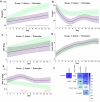Psilocybin increases optimistic engagement over time: computational modelling of behaviour in rats
- PMID: 39349428
- PMCID: PMC11442808
- DOI: 10.1038/s41398-024-03103-7
Psilocybin increases optimistic engagement over time: computational modelling of behaviour in rats
Abstract
Psilocybin has shown promise as a novel pharmacological intervention for treatment of depression, where post-acute effects of psilocybin treatment have been associated with increased positive mood and decreased pessimism. Although psilocybin is proving to be effective in clinical trials for treatment of psychiatric disorders, the information processing mechanisms affected by psilocybin are not well understood. Here, we fit active inference and reinforcement learning computational models to a novel two-armed bandit reversal learning task capable of capturing engagement behaviour in rats. The model revealed that after receiving psilocybin, rats achieve more rewards through increased task engagement, mediated by modification of forgetting rates and reduced loss aversion. These findings suggest that psilocybin may afford an optimism bias that arises through altered belief updating, with translational potential for clinical populations characterised by lack of optimism.
© 2024. The Author(s).
Conflict of interest statement
We would like to acknowledge A/Prof Alexxai Kravitz (Washington University in St Louis) for input into task design and operations and the USONA Institute Investigational Drug Supply Program (Madison, WI) for providing the psilocybin used in these studies. We acknowledge the use of Biorender for aspects of the figures. This work was supported by a National Health and Medical Research Council Grant (Grant No. GNT2011334) to CJF and a Three Springs Foundation Grant awarded to JH. CJF sits on the scientific advisory board for Octarine Bio, Denmark. No other authors report biomedical financial interests or potential conflicts of interests.
Figures





References
-
- Mason NL, Mischler E, Uthaug MV, Kuypers KPC. Sub-Acute Effects of Psilocybin on Empathy, Creative Thinking, and Subjective Well-Being. J Psychoactive Drugs. 2019;51:123–34. - PubMed
-
- Goldberg SB, Pace BT, Nicholas CR, Raison CL, Hutson PR. The experimental effects of psilocybin on symptoms of anxiety and depression: A meta-analysis. Psychiatry Res. 2020;284:112749. - PubMed
-
- Prouzeau D, Conejero I, Voyvodic PL, Becamel C, Abbar M, Lopez-Castroman J. Psilocybin Efficacy and Mechanisms of Action in Major Depressive Disorder: a Review. Curr Psychiatry Rep. 2022;24:573–81. - PubMed
MeSH terms
Substances
Grants and funding
LinkOut - more resources
Full Text Sources

